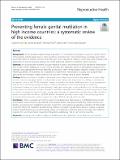Preventing Female Genital Mutilation in High Income Countries: a Systematic Review of the Evidence
View/
Publication Date
2019-07views
downloads
Metadata
Show full item recordCitation
Njue C, Karumbi J, Esho T, Varol N, Dawson A. Preventing female genital mutilation in high income countries: a systematic review of the evidence. Reprod Health. 2019 Jul 22;16(1):113. doi: 10.1186/s12978-019-0774-x. PMID: 31331357; PMCID: PMC6647166.
Abstract/
Background: Female genital mutilation (FGM) is prevalent in communities of migration. Given the harmful effects of the practice and its illegal status in many countries, there have been concerted primary, secondary and tertiary prevention efforts to protect girls from FGM. However, there is paucity of evidence concerning useful strategies and approaches to prevent FGM and improve the health and social outcomes of affected women and girls. Methods: We analysed peer-reviewed and grey literature to extract the evidence for FGM prevention interventions from a public health perspective in high income countries by a systematic search of bibliographic databases and websites using appropriate keywords. Identified publications were screened against selection criteria, following the PRISMA guidelines. We examined the characteristics of prevention interventions, including their programmatic approaches and strategies, target audiences and evaluation findings using an apriori template. Findings: Eleven documents included in this review described primary and secondary prevention activities. High income countries have given attention to legislative action, bureaucratic interventions to address social injustice and protect those at risk of FGM, alongside prevention activities that favour health persuasion, foster engagement with the local community through outreach and the involvement of community champions, healthcare professional training and capacity strengthening. Study types are largely process evaluations that include measures of short-term outcomes (pre- and post-changes in attitude, knowledge and confidence or audits of practices). There is a dearth of evaluative research focused on empowerment-oriented preventative activities that involve individual women and girls who are affected by FGM. Beattie's framework provides a useful way of articulating negotiated and authoritative prevention actions required to address FGM at national and local levels. Conclusion: FGM is a complex and deeply rooted sociocultural issue that requires a multifaceted response that encompasses socio-economic, physical and environmental factors, education and learning, health services and facilities, and community mobilisation activities. Investment in the rigorous longitudinal evaluation of FGM health prevention efforts are needed to provide strong evidence of impact to guide future decision making. A national evidence-based framework would bring logic, clarity, comprehension, evidence and economically more effective response for current and future prevention interventions addressing FGM in high income countries. Keywords: Female genital mutilation; Health prevention; High-income countries; Migrants; Systematic review.
Subject/
Female genital mutilation; Health prevention; High-income countries; Migrants; Systematic review
Collections
- General - GEN [367]

